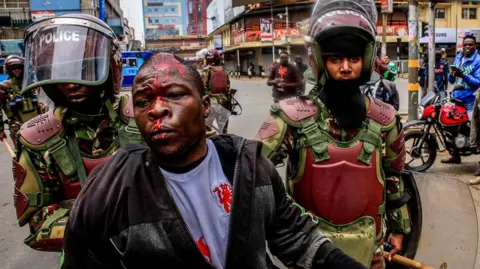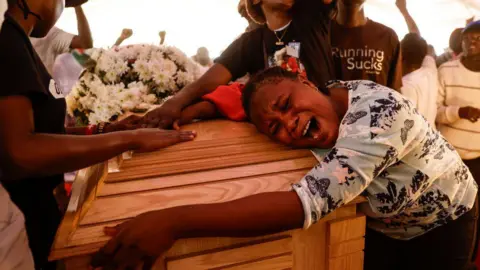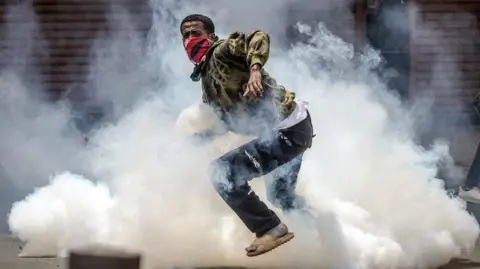 Getty Photos
Getty PhotosThe latest wave of the deaths of dozens of individuals in Kenya, as police cracked down on protests countrywide, started with the capturing of 30-year-old Rex Masai.
The killings have additional eroded what little belief there was within the police to take care of order. And as a brand new collection of protests is about to start, there are issues over how the safety forces will reply.
WARNING: This piece comprises descriptions of violence that some readers might discover distressing.
20 June noticed the second day of demonstrations in opposition to a finance invoice that was going to boost new taxes. Yesterday of motion had been with out main incidents, however as solar set on that Thursday one thing modified within the coronary heart of the capital, Nairobi.
The protesters grew to become extra defiant. Law enforcement officials switched from utilizing water cannon and tear gasoline to firing reside bullets.
Mr Masai obtained caught on the unsuitable finish of that. He was shot within the thigh and bled to dying.
“His blood was throughout my palms,” says his buddy, Ian Njuguna, who rushed to attempt to assist him when he fell to the bottom.
However as he and one other buddy tried to hold him to a close-by hospital “the officer tear-gassed us [as] we had been carrying our dying buddy”.
“We had been frantically attempting to talk to him, pleading with him to not depart us.”
A minimum of 4 cops thus far are to face prosecution for capturing and killing protesters during the last 4 weeks, amid rising requires justice for victims of the alleged extreme use of power.
However the investigations have been tough.
“We now have encountered non-cooperation from the police and to a sure degree some intimidation even to our officers,” John Waiganjo, a commissioner from the Unbiased Policing Oversight Authority (IPOA), advised the BBC.
 Getty Photos
Getty PhotosHowever the investigation into the killing of Mr Masai has not but resulted within the begin of a prosecution, as investigators search to collect extra proof and document statements.
Mr Waiganjo didn’t touch upon this particular case however defined that when investigating harm or dying the IPOA wants info on the place the weapons concerned had been from and the identification of the officers allegedly concerned.
The BBC has verified a video filmed across the similar time and sure the identical place that Mr Masai was killed, exhibiting what seems to be a plain-clothes police officer capturing at a crowd of protesters who had been fleeing alongside a road.
Mr Njuguna says he thought his buddy was profiled by the officer who shot him as a result of he had dreadlocks.
“He was accused of stealing a telephone. There was a store that was looted. So, they thought he was one of many looters, in order that they shot him – due to what? Dreadlocks,” he tells the BBC, sounding indignant and annoyed.
On the evening he was killed, Mr Masai’s household says the physician who pronounced him useless confirmed there was a bullet lodged in his thigh, with a wound seen on one aspect however no exit wound on the opposite.
“Once I obtained to [where he died], I requested the medics to uncover my son’s physique,” his mom, Gillian Munyao, advised the BBC a day after the incident. She noticed the place the bullet had entered his leg.
After the post-mortem, the household and associates of Mr Masai had been shocked to be taught that bullet couldn’t be present in his physique. They suspected that it was eliminated in some unspecified time in the future.
When the BBC advised Mr Waiganjo of the allegation of a scarcity of bodily proof, he was not stunned, given the IPOA’s personal challenges securing objects to assist their investigations.
This may derail the search for justice regardless of the IPOA’s powers to compel establishments at hand over any important info.
The BBC contacted performing head of police Douglas Kiricho for a response to the allegations of obstructing investigations and of utilizing extreme power in opposition to protesters.
Whereas he acknowledged the request and instructed the police spokesperson to reply to our particular questions, no response had been obtained by the point of publishing this story regardless of a number of reminders.
 AFP
AFPThe conduct of police has left many Kenyans with little religion within the system.
It’s unsurprising that the IPOA says it has struggled to get witnesses to document statements in Mr Masai’s case or the others, as individuals are usually scared to return ahead. The IPOA is utilizing allegations shared on social media of killings, arbitrary arrests and abductions to provoke investigations.
Trying throughout the weeks of protests as a complete, BBC Confirm has discovered dozens of movies which seem to indicate what activists and the police oversight physique say would quantity to extreme use of power and violations by the police as they quelled the protests.
The BBC has managed to confirm the areas and time the incidents that occurred by evaluating landmarks we will see within the video with Google Road View imagery and satellite tv for pc maps, native media reporting and different movies exhibiting the identical occasions.
The movies vary from capturing at unarmed protesters, beatings with batons, assaults on individuals providing first support, assaults on journalists and abductions.
In a single video filmed alongside subsequent to the Parliament buildings a protester is seen strolling in the direction of the police along with his arms raised. Moments later, pictures ring out.
We later see him being bundled into the again of a police car, with wounds on each legs, screaming.
“I haven’t performed something, I haven’t burned any car… they’ve shot me for nothing,” he says, as he exhibits the injuries on his legs.
“It’s not justified to make use of reside fireplace and even rubber bullets on people who find themselves unarmed, and primarily not confronting the police violently,” says Irungu Houghton, the manager director of the Kenyan department of rights group Amnesty Worldwide.
He argues that there’s a clear authorized framework for policing within the nation. “You possibly can’t go multiple web page with out studying the phrases human rights and repair to residents.”
However he reckons the issue is deep-rooted within the system: “Slightly than de-escalating conversations, or primarily facilitating peaceable protests, what we have seen is an try to attempt to block peaceable protests. And that is the place issues break down.”
He argues that policing can work if the management is obvious that the position of the police is to de-escalate tensions.
“If demonstrations are peaceable, the police should not supposed to make use of any tear gasoline canisters or water cannons, and even reside bullets,” Mr Waiganjo says.
Their position is to information protesters alongside an agreed-on path, and “can solely use firearms when an individual’s life is at risk”.
Requested if she was assured justice can be served, Mr Masai’s mom stated: “You know the way authorities works right here however let me belief for the very best.”
“I’d say to the police, within the upcoming protests, they’re dad and mom simply as we’re. The ache we really feel ought to be theirs. We gained’t take revenge. We depart it to God.”
Extra BBC tales on the protests in Kenya:
 Getty Photos/BBC
Getty Photos/BBC



